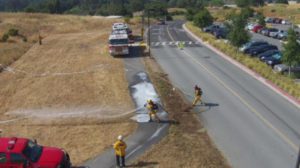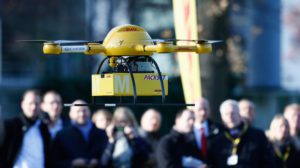Drones are a safe and efficient alternative method that we anticipate will become the norm for transmission line, cell tower, and energy inspection. Choosing the right drone provider, UAV, sensor, and payload will extend drone flight times, and offer high-resolution thermal and/or optical zoom inspection capabilities for more efficient and safe inspections.
The communications, energy, and clean energy industries are perpetually gathering information for risk management from infrastructure monitoring, pipeline inspections, to encroaching trees and foliage on transmission lines.
Commercial drones are changing the way operators are auditing and inspecting wireless, and power line infrastructure by enabling a safer collection of high-resolution imagery and video of pipelines, wind turbines, tower structures, and equipment.
- Recent studies find 1 in 3 cell tower climbs may be eliminated when aerial drone inspection becomes a routine, safe, efficient unmanned aircraft exercise
- Locate potential hot spots within power transmission, distribution and substation systems
- Map an entire solar array within minutes to identify electrical shunt defects
- Perform maintenance on wind turbines with thermal to mitigate gearbox brake failure
- Locate hot spots on boiler tubes with thermal inspection before critical failures
- Detect thermal deficiencies in HVAC systems with thermal inspection
Oil and Gas inspection:
The challenge today: Pipelines traverse inhospitable terrain. Drilling rigs are hundreds of miles offshore. Refineries and production facilities may emit dangerous hydrocarbons. On top of these safety concerns, operational inspections are expensive frequently taking place far from a base of operations and employing expensive helicopters and teams. How can 1UP assist? Drones are becoming standard tools for drilling rig and production platform inspection. Drones are even being used to monitor fracking sites for various gases being emitted.
Drone pipeline inspection, monitoring and maintenance
Like many other industries drone efficiency can assist midstream-focused oil and gas companies that traditionally use aerial surveillance and ground crews to monitor existing pipelines. Many pipeline operators inspect above-ground pipelines aerially at least monthly to meet federal and state requirements. 1UP believes we have a more efficient method of inspection than the Industry standard pricing for a helicopter crew ($2,500-$4,500 per hour depending on whether the service is an aerial inspection or involves sophisticated sensing equipment). According to the EIA, the US has more than 305,000 miles of interstate and intrastate natural gas transmission pipelines, in addition to over 55,000 miles of crude oil trunk lines and thousands of miles of additional lateral crude gathering lines. Many of these pipelines are constructed below ground, and therefore do not require much aerial?monitoring. However there are many abandoned pipelines and wells above ground that thermal inspections are a necessity to be in compliance with applicable regulations.
The main risk posed by an oil or gas pipeline is the existence of a spill or a leakage that threatens to cause an environmental disaster, not to mention the risk of an explosion. A thorough system for pipeline monitoring requires the use of specific drone sensors that can detect rust or corrosion – or if the pipeline is beneath the ground, the existence of methane or changes in the surrounding vegetation that indicate a failure. One of the main benefits of using drones for oil and gas inspection is they can be programmed to cover large areas in a systematic way, as well as get to difficult to reach areas. Not only is this more cost-effective, but it allows inspectors a safe, flexible solution to many issues of restricted access, which may prove crucial in identifying a problem.


